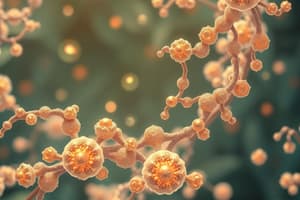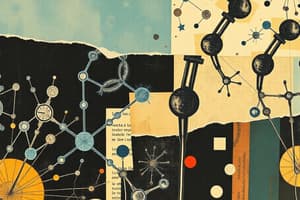Podcast
Questions and Answers
What role do enzymes play in biochemical reactions?
What role do enzymes play in biochemical reactions?
- They store energy for metabolic processes.
- They function as structural components of cells.
- They accelerate reactions by lowering activation energies. (correct)
- They create substrates for reactions.
Which statement correctly describes the primary structure of a protein?
Which statement correctly describes the primary structure of a protein?
- It refers to the interaction of multiple polypeptide chains.
- It is the 3D arrangement of the polypeptide chain.
- It involves the folding of the protein into alpha-helices.
- It is the sequence of amino acids in a chain. (correct)
Which type of RNA is primarily responsible for carrying information from DNA to the ribosome for protein synthesis?
Which type of RNA is primarily responsible for carrying information from DNA to the ribosome for protein synthesis?
- mRNA (correct)
- tRNA
- rRNA
- snRNA
What is the primary role of carbohydrates in living organisms?
What is the primary role of carbohydrates in living organisms?
What is the function of cell membranes according to the fluid mosaic model?
What is the function of cell membranes according to the fluid mosaic model?
Which statement best describes lipids?
Which statement best describes lipids?
What is a crucial step in the process of cellular respiration that occurs in the mitochondria?
What is a crucial step in the process of cellular respiration that occurs in the mitochondria?
What distinguishes the structure of proteins from other biomolecules?
What distinguishes the structure of proteins from other biomolecules?
Denaturation of a protein can disrupt its function. Which factor can lead to this change?
Denaturation of a protein can disrupt its function. Which factor can lead to this change?
What is the function of nucleic acids in living organisms?
What is the function of nucleic acids in living organisms?
Which mechanism of enzyme inhibition involves the inhibitor competing with the substrate for the active site?
Which mechanism of enzyme inhibition involves the inhibitor competing with the substrate for the active site?
What is the primary role of tRNA during translation?
What is the primary role of tRNA during translation?
What is an example of catabolism in metabolism?
What is an example of catabolism in metabolism?
Which of the following statements about metabolic pathways is true?
Which of the following statements about metabolic pathways is true?
How are proteins classified based on their structure?
How are proteins classified based on their structure?
Which metabolic process requires energy input?
Which metabolic process requires energy input?
Flashcards
Biochemistry definition
Biochemistry definition
The study of chemical processes within and relating to living organisms.
Biomolecules
Biomolecules
Carbohydrates, lipids, proteins, and nucleic acids.
Carbohydrates function
Carbohydrates function
Provide energy and structural support; sugars and starches.
Proteins structure-function
Proteins structure-function
Signup and view all the flashcards
Nucleic acids role
Nucleic acids role
Signup and view all the flashcards
Catabolism
Catabolism
Signup and view all the flashcards
Anabolism
Anabolism
Signup and view all the flashcards
Metabolism
Metabolism
Signup and view all the flashcards
Enzyme
Enzyme
Signup and view all the flashcards
Protein Structure
Protein Structure
Signup and view all the flashcards
Protein Folding
Protein Folding
Signup and view all the flashcards
DNA
DNA
Signup and view all the flashcards
RNA
RNA
Signup and view all the flashcards
Biological Membrane
Biological Membrane
Signup and view all the flashcards
Cellular Respiration
Cellular Respiration
Signup and view all the flashcards
Enzyme Inhibition
Enzyme Inhibition
Signup and view all the flashcards
Study Notes
Introduction to Biochemistry
- Biochemistry is the study of chemical processes within and relating to living organisms.
- It encompasses a wide range of topics, from the simplest molecules to complex biological systems.
- Key areas of study include: metabolism, enzyme function, protein structure and function, and the role of nucleic acids in heredity.
- The study of biomolecules (carbohydrates, lipids, proteins, and nucleic acids) is central to biochemistry.
- Understanding these molecules is crucial to understanding the functions of living organisms.
- Investigating interactions between these molecules further unveils biological processes.
Biomolecules
- Carbohydrates:
- Primarily composed of carbon, hydrogen, and oxygen.
- Provide energy and structural support.
- Examples include sugars (glucose, fructose) and starches.
- Classified by the number of sugar units (monosaccharides, disaccharides, polysaccharides).
- Lipids:
- Diverse group of hydrophobic molecules.
- Primarily composed of carbon and hydrogen.
- Important for energy storage, insulation, and membrane structure.
- Examples include fats, oils, and steroids.
- Proteins:
- Complex polymers of amino acids.
- Crucial for structural support, catalysis (enzymes), transport, and regulation.
- Their structure (primary, secondary, tertiary, and quaternary) dictates function.
- Different types include fibrous and globular proteins.
- Nucleic Acids:
- Deoxyribonucleic acid (DNA) and ribonucleic acid (RNA).
- Carry genetic information.
- DNA stores genetic instructions while RNA transmits and performs functions using those instructions.
- Composed of nucleotides, each with a sugar, phosphate, and base.
Metabolism
- Metabolism encompasses all chemical reactions in a cell.
- It broadly categorized into:
- Catabolism: The breakdown of complex molecules into simpler ones, often releasing energy.
- Anabolism: The synthesis of complex molecules from simpler ones, requiring energy input.
- Cellular respiration is a crucial catabolic pathway that releases energy stored in glucose.
- Various metabolic pathways exist in organisms, including glycolysis, the Krebs cycle, and the electron transport chain all vital in energy production.
- Metabolic pathways are highly regulated, ensuring appropriate synthesis and breakdown according to cellular needs.
Enzymes
- Enzymes are biological catalysts, typically proteins, that accelerate biochemical reactions by lowering activation energies.
- They are highly specific, interacting with particular substrates at their active sites.
- Factors affecting enzyme activity include temperature, pH, and substrate concentration.
- Enzyme inhibition can regulate metabolic pathways to control the cell's activity levels by various mechanisms, including competitive and noncompetitive inhibition.
Protein Structure and Function
- Protein structure is directly correlated to function.
- The primary structure (amino acid sequence) determines the higher-order structure.
- Secondary structure involves alpha-helices and beta-sheets.
- Tertiary structure is the 3D arrangement of the polypeptide chain.
- Quaternary structure describes the interaction of multiple polypeptide chains.
- Protein folding is a crucial process that influences protein function by allowing correct interactions between amino acid residues.
- Denaturation can disrupt protein structure and function, often by changes in temperature or pH.
Nucleic Acids and Genetics
- DNA (deoxyribonucleic acid) stores the genetic information.
- DNA replication is essential for cell division and passing on genetic information.
- RNA (ribonucleic acid) carries out various functions in gene expression and translation.
- Different types of RNA (mRNA, tRNA, rRNA) play specific roles in protein synthesis.
- Gene expression involves the transcription of DNA into mRNA and the subsequent translation of mRNA into proteins.
- This process, governed by complex regulatory mechanisms, dictates cellular activities and responses in living organisms.
Biological Membranes
- Membranes are essential biological structures forming boundaries for cells and organelles.
- Composed of phospholipids, proteins, and carbohydrates.
- The fluid mosaic model describes membranes as fluid structures where proteins are embedded within the phospholipid bilayer.
- Membranes are selectively permeable, allowing certain substances to pass through while restricting others.
- Important for regulating transport of molecules into and out cells.
- Transport mechanisms across the membrane can be active or passive, involving proteins and other molecules.
Cellular Respiration
- Cellular respiration is a fundamental process producing ATP (energy currency of the cell).
- Glycolysis, the Krebs cycle, and the electron transport chain are crucial steps in respiration.
- It occurs both aerobically and anaerobically, generating differing amounts of ATP.
- Regulation of cellular respiration ensures appropriate energy production and distribution as needed by the organism.
Cell Signalling
- Cellular signaling enables communication between cells and within organisms.
- Signaling pathways involve a series of molecular events that transmit information.
- Ligands, receptors, and second messengers are pivotal elements in signaling pathways.
- Key signaling pathways regulate various cellular processes, including growth, differentiation, and metabolism.
Studying That Suits You
Use AI to generate personalized quizzes and flashcards to suit your learning preferences.




